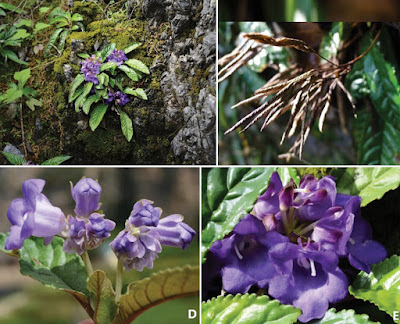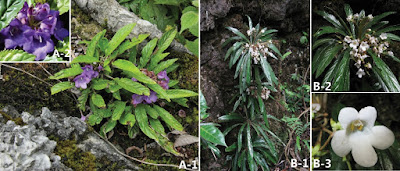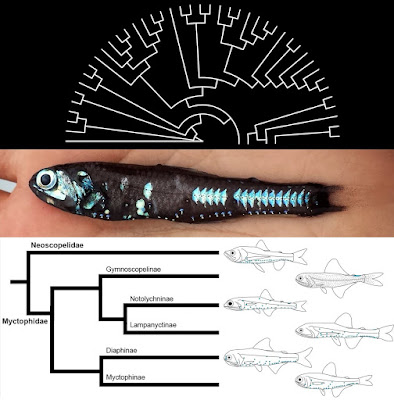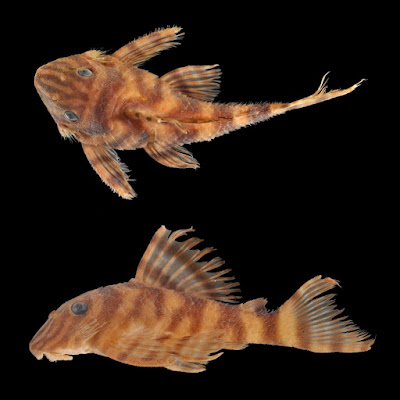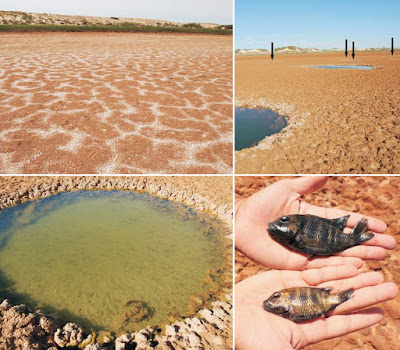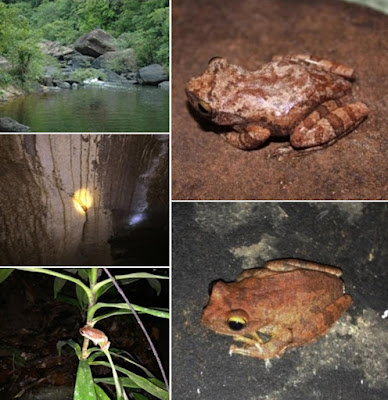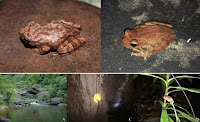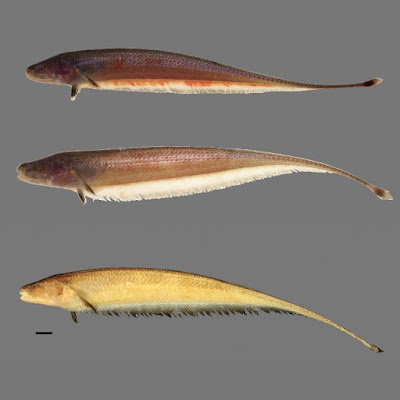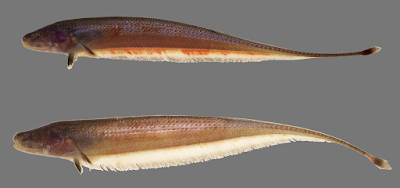[Most Recent Entries] [Calendar View]
Tuesday, February 13th, 2018
| Time | Event | ||||||
| 1:46a | [Botany • 2018] Paraboea wenshanensis • A New Species of Gesneriaceae from Yunnan, China
Abstract Paraboea wenshanensis is a new species of Gesneriaceae from Yunnan, China and is described and illustrated here. It is morphologically similar to P. angustifolia, P. martinii and P. glutinosa, but the congeners of this new taxon can be distinguished by several salient characters. A description of P. wenshanensis, together with illustrations and photographs, a distribution map and conservation assessment are presented. Keywords: Limestone flora, karst, new taxon Paraboea wenshanensis X.Hong & F.Wen, sp. nov. Diagnosis: Paraboea wenshanensis is similar to P. martinii (H. Lév. & Vaniot) B.L. Burtt and P. glutinosa (Hand.-Mazz.) K.Y. Pan in having similar corolla shape and colour, but can be distinguished by its oblong-ovate to elliptic leaf blade, crenate margin, lateral veins 4–8 on each side of midrib, petiole subsessile or up to 3 cm long, broadly obovate, glabrous bracts, 6–8 mm long, glabrous membranous calyx and capitate staminodes. It also morphologically resembles P. angustifolia Yan Liu & W.B. Xu, but can be easily distinguished by the oblong-ovate to elliptic leaf blade, broadly obovate, glabrous bracts, oblong to oblanceolate, glabrous membranous calyx, sparsely glandular puberulent filaments; capitate staminodes and twisted capsule. A morphological comparison between P. wenshanensis and congeners: P. angustifolia, P. martinii and P. glutinosa is provided in Table 1.
..... Etymology: The specific epithet is derived from the type locality, Wenshan National Nature Reserve, Yunnan Province, China. Vernacular name: Wén Shān Zhǖ Máo Jǜ Tái (Chinese pronunciation); 文山蛛毛苣苔 (Chinese name). Distribution and habitat: To date, Paraboea wenshanensis is locally abundant and endemic to south-western China, from type locality: Wenshan Nature Reserve, Wenshan Zhuang and Miao Autonomous Prefecture, Yunnan province. This species grows on moist shady cliffs of limestone hills, at an elevation of 1,500 m a.s.l. The average temperature is 14.5 °C, the average annual precipitation has been calculated as ca. 1,022 mm. The forest is a subtropical monsoon climate evergreen broad-leaved forest, with main community types of Ilex polyneura (Hand.-Mazz.) S.Y. Hu, Triadica rotundifolia (Hemsl.) Esser and Debregeasia orientalis C.J. Chen. De-Ming He, Yan-Fei Feng, Fu-Zhuan Pan, Xin Hong and Fang Wen. 2018. Paraboea wenshanensis, A New Species of Gesneriaceae from Yunnan, China. PhytoKeys. 95; 83-91. DOI: 10.3897/phytokeys.95.21586 | ||||||
| 1:55a | [Ichthyology • 2018] Order Myctophiformes • Light in the Darkness: New Perspective on Lanternfish Relationships and Classification using Genomic and Morphological Data
Highlights • This is the first phylogenetic study to integrate morphological and molecular data to specifically address the relationships within Myctophiformes. • This study presents the first hypotheses of evolutionary relationships of lanternfishes that includes a phylogenomic dataset. • A revised classification of lanternfishes is presented that includes five subfamilies within the family Myctophidae. • The Diaphinae are recovered as the sister group to the Myctophinae. Abstract Massive parallel sequencing allows scientists to gather DNA sequences composed of millions of base pairs that can be combined into large datasets and analyzed to infer organismal relationships at a genome-wide scale in non-model organisms. Although the use of these large datasets is becoming more widespread, little to no work has been done in estimating phylogenetic relationships using UCEs in deep-sea fishes. Among deep-sea animals, the 257 species of lanternfishes (Myctophiformes) are among the most important open-ocean lineages, representing half of all mesopelagic vertebrate biomass. With this relative abundance, they are key members of the midwater food web where they feed on smaller invertebrates and fishes in addition to being a primary prey item for other open-ocean animals. Understanding the evolution and relationships of midwater organisms generally, and this dominant group of fishes in particular, is necessary for understanding and preserving the underexplored deep-sea ecosystem. Despite substantial congruence in the evolutionary relationships among deep-sea lanternfishes at higher classification levels in previous studies, the relationships among tribes, genera, and species within Myctophidae often conflict across phylogenetic studies or lack resolution and support. Herein we provide the first genome-scale phylogenetic analysis of lanternfishes, and we integrate these data from across the nuclear genome with additional protein-coding gene sequences and morphological data to further test evolutionary relationships among lanternfishes. Our phylogenetic hypotheses of relationships among lanternfishes are entirely congruent across a diversity of analyses that vary in methods, taxonomic sampling, and data analyzed. Within the Myctophiformes, the Neoscopelidae is inferred to be monophyletic and sister to a monophyletic Myctophidae. The current classification of lanternfishes is incongruent with our phylogenetic tree, so we recommend revisions that retain much of the traditional tribal structure and recognize five subfamilies instead of the traditional two subfamilies. The revised monophyletic taxonomy of myctophids includes the elevation of three former lampanyctine tribes to subfamilies. A restricted Lampanyctinae was recovered sister to Notolychninae. These two clades together were recovered as the sister group to the Gymnoscopelinae. Combined, these three subfamilies were recovered as the sister group to a clade composed of a monophyletic Diaphinae sister to the traditional Myctophinae. Our results corroborate recent multilocus molecular studies that infer a polyphyletic Myctophum in Myctophinae, and a para- or polyphyletic Lampanyctus and Nannobrachium within Lampanyctinae. We resurrect Dasyscopelus and Ctenoscopelus for the independent clades traditionally classified as species of Myctophum, and we place Nannobrachium into the synonymy of Lampanyctus. Keywords: Phylogenomic, Evolution, Deep Sea, Taxonomy, Classification Rene P. Martin, Emily E. Olson, Matthew G. Girard, Wm. Leo Smith and Matthew P. Davis. 2018. Light in the Darkness: New Perspective on Lanternfish Relationships and Classification using Genomic and Morphological Data. Molecular Phylogenetics and Evolution. 121; 71-85. DOI: 10.1016/j.ympev.2017.12.029 | ||||||
| 10:58a | [Ichthyology • 2016] Panaqolus claustellifer • A New Species of Panaqolus (Siluriformes: Loricariidae) from the rio Branco
A new species of Panaqolus is described from material from the Takutu River and the mainstem rio Branco. The new species is diagnosed from congeners by its color pattern consisting of dark and light bars on the body, bands on the fins, and with dots and vermiculations absent (vs. no bars in P. albomaculatus, P. nix, P. nocturnus, and P. koko, vs. fins unbanded in P. albomaculatus, P. dentex, P. koko, and P. nix, and vs. dots and vermiculations present in P. albivermis and P. maccus). The new species is diagnosed from barred species of Panaqolus by its specific bar number and orientation and color pattern on its head, with bars oriented in a anteroventral-posterodorsal direction (vs. anterodorsal-posteroventral bars in P. gnomus), having consistently 5 bars (n = 4) on the trunk that do not increase with size (vs. number increasing with size in P. purusiensis and vs. 6-12 in P. changae), and the color pattern on the head of straight lines extending from posterior to the eye to the snout margin, splitting in the middle portion of the line in larger specimens (vs. small, dense reticulate lines in P. changae). Biogeographically, we infer that the new species ancestrally originated in the Amazon river, dispersing to the Takutu River after the Amazon captured part of the Proto-Berbice. Keywords: Brazil, Guyana, Hypostominae, Takutu River.
Panaqolus claustellifer, new species Diagnosis. Panaqolus claustellifer is diagnosed from most other described species of Panaqolus by its color pattern of dark and light bars on the body, bands on the fins, and with dots and vermiculations absent (vs. no bars in P. albomaculatus, P. nix, P. nocturnus, and P. koko, vs. fins unbanded in P. albomaculatus, P. dentex, P. koko, and P. nix, and vs. dots and vermiculations present in P. albivermis and P. maccus ). Additionally, Panaqolus claustellifer is diagnosed from P. albivermis, P. albomaculatus, and P. nix by dentaries forming an acute angle ~70º vs. dentaries forming a very acute angle to dentaries parallel), and from P. koko by spoon-shaped teeth with small lateral cusps vs. quadrate teeth with strong lateral cusps. Panaqolus claustellifer is diagnosed from other barred species of Panaqolus by the specific bar number and orientation and color pattern on the head, with bars oriented in a anteroventral-posterodorsal direction (vs. anterodorsal-posteroventral bars in P. gnomus), having consistently 5 bars (n = 4) on the trunk that do not increase with size (vs. number increasing with size in P. purusiensis and fading at body sizes >85 mm SL, and vs. 6-12 in P. changae), and the color pattern on the head of straight lines extending from posterior to the eye to the snout margin, splitting in the middle portion of the line in larger specimens (vs. small, dense reticulate lines in P. changae). Etymology. From the Latin claustellum , meaning keyhole, and the Latin fero , meaning to bear. Refers to the dark brown lines on the snout surrounding a keyhole-like shape of light-brown base coloration. Treated as a masculine adjective. Ecological notes. Individuals of Panaqolus claustellifer were found in shallow cataracts along the Takutu river, a whitewater system. The substrate was sandy with lateritic rocks interspersed. Surrounding habitat consisted of a narrow strip of gallery forest, but mostly savanna. Small specimens <20 mm SL (AUM 47717, AUM 65708) likely represent young-of-year that have hatched less than a couple weeks prior to collection. Distribution. Panaqolus claustellifer occurs in the Takutu river and the mainstem rio Branco of Brazil and Guyana. Milton Tan, Lesley S. de Souza and Jonathan W. Armbruster. 2016. A New Species of Panaqolus (Siluriformes: Loricariidae) from the rio Branco. Neotropical Ichthyology. 14(2); e150033. DOI: 10.1590/1982-0224-20150033 Uma espécie nova de Panaqolus é descrita do rio Branco e seu afluente, rio Tacutu. A nova espécie é diagnosticada de suas congêneres pelo padrão de colorido composto por barras escuras e claras alternadas no corpo e nadadeiras, não formando máculas ou vermiculações nas nadadeiras (vs. sem barras no corpo em P. albomaculatus, P. nix, P. nocturnus, e P. koko, e vs. sem barras nas nadadeiras em P. albomaculatus, P. dentex, P. koko, e P. nix, e vs. máculas e vermiculações presentes em P. albivermis e P. maccus). A nova espécie é diagnosticada das espécies de Panaqolus com barras pelo número e orientação das barras e pelo padrão de colorido cefálico, com as barras orientadas posterodorsalmente (vs. posteroventralmente em P. gnomus), pela presença de cinco barras (n = 4) no tronco que não aumentam com o tamanho (vs. número aumentando com o tamanho em P. purusiensis e vs. 6-12 barras em P. changae), e o padrão de colorido cefálico composto por linhas retas da margem posterior do olho à margem do focinho, dividida medianamente em indivíduos maiores (vs. linhas pequenas e vermiculadas em P. changae). Nos inferimos que a nova espécie originou-se ancestralmente no rio Amazonas, dispersando para o rio Tacutu após o Amazonas capturar parte do Proto-Berbice. | ||||||
| 1:45p | [Ichthyology • 2018] A Euryhaline Fish, Lost in the Desert: The Unexpected Metapopulation Structure of Coptodon guineensis (Günther, 1862) in the Sebkha of Imlili, Morocco
Abstract Euryhaline Cichlid fish of the species Coptodon guineensis are present in different water holes situated in a dried depression in the desert in the extreme South of Morocco, the Sebkha of Imlili. A genetic survey of this population, using complete sequences of the ND2 gene (mtDNA) and sixteen microsatellite loci, revealed that the fish in the sebkha did not form a single population, but rather a metapopulation. This metapopulational structure may be regarded as good news from the point of view of the conservation of fish in the sebkha. Although small individual populations may have short, finite life spans, the metapopulation as a whole is more stable, because immigrants from one population are likely to re-colonize the habitat, left open by the extinction of another. Keywords: Tilapia; Conservation; Endangered species Jean-François Agnèse, Halima Louizi, André Gilles, Ouafae Berrada Rkhami, Abdelaziz Benhoussa, Abdeljebbar Qninba and Antoine Pariselle. 2018. A Euryhaline Fish, Lost in the Desert: The Unexpected Metapopulation Structure of Coptodon guineensis (Günther, 1862) in the Sebkha of Imlili [Un poisson euryhalin perdu dans le désert : structure métapopulationnelle inattendue de Coptodon guineensis (Günther, 1862) dans la Sebkha d’Imili]. Comptes Rendus Biologies. In Press. DOI: 10.1016/j.crvi.2018.01.002 | ||||||
| 1:49p | [Herpetology • 2018] On The Identities of Rhacophorus jarujini and Rhacophorus orlovi (Anura, Rhacophoridae) from Thailand
Abstract We investigated the respective identities of Rhacophorus jarujini and R. orlovi in Thailand based on specimens collected from several localities in north-eastern Thailand and specimens from museums, namely American Museum of Natural History, Field Museum of Natural History, North Carolina State Museum of Natural Science, Khon Kaen University Vertebrates Collection and Thailand Natural History Museum. Our results confirm that the specimens from Amnat Charoen and Ubon Ratchathani provinces, Thailand, which were previously identified as R. orlovi, are in fact R. jarujini. We therefore propose removing R. orlovi from the list of amphibian fauna of Thailand and that former records of R. orlovi should be replaced by R. jarujini. Furthermore, we report a new record of R. jarujini based on specimens collected from Phu Phan National Park (Sakon Nakhon province), the northernmost record of the species in Thailand. Keywords: Rhacophorus jarujini, Rhacophorus orlovi, morphology, species distribution, Thailand
CONCLUSIONS: Examination of specimens of Rhacophorus jarujini and R. orlovi from Thailand confirms the uniqueness of these two species based on external morphological and morphometrical characters. The results confirm that all specimens from Thailand, which were previously identified as Rhacophorus orlovi, are in fact R. jarujini. The present distribution of R. jarujini is known to be from the provincial areas of Sakon Nakhon, Kalasin, Roi Et, Amnat Charoen and Ubon Ratchathani. Prapaiporn Thongproh, Montri Youjaroen, Yodchaiy Chuaynkern, Chantip Chuaynkern, Pramote Ratree, Prateep Duengkae, Ekachai Phetcharat, Wassana Maiprom, Wimol Ungprombundith and Teerayut Wongpaiseart. 2018. On The Identities of Rhacophorus jarujini Matsui and Panha, 2006 and Rhacophorus orlovi Ziegler and Köhler, 2001 (Amphibia, Anura, Rhacophoridae) from Thailand. Maejo International Journal of Science and Technology [Maejo Int. J. Sci. Technol.]. 12(1); 36-50. | ||||||
| 1:50p | [Ichthyology • 2018] Melanosternarchus amaru • A New Genus and Species of Electric Ghost Knifefish (Gymnotiformes: Apteronotidae) from the Amazon Basin
Abstract We describe Melanosternarchus amaru as a new genus and species of Apteronotidae from the deep channels of blackwater and clearwater tributaries of the Amazon River in Brazil and Peru. The new species superficially resembles members of the widespread “Apteronotus” bonapartii species group, from which it can be readily distinguished by expanded bones of the infraorbital laterosensory canal. It can further be distinguished from all other apteronotids by a unique combination of characters: reduced premaxillary dentition, a large gape, and an absence of scales from the entire dorsum. A molecular phylogenetic analysis using three mitochondrial loci and one nuclear locus (~3000 bp) places this genus as sister to Compsaraia, and these two genera together as a clade sister to Pariosternarchus; all nodes with strong statistical support. The clade formed by these three genera includes five species, four of which are restricted to the Amazon basin. The apparent habitat preference of the new species for low-conductivity blackwater and clearwater rivers has not been reported in other apteronotid species. Keywords: Pisces, Neotropics, Peru, Brazil, diversity, Blackwater, taxonomy  
Melanosternarchus, new genus Type species. Melanosternarchus amaru, new species, by monotypy and original designation. Etymology. Melano from the Greek melas, meaning black in reference to dark pigmentation and presence in blackwater rivers, and sternarchus, a name commonly used in apteronotid taxonomy, from the Greek sternon (chest) and archos (rectum), referring to the anterior position of the anus. Melanosternarchus amaru, new species Etymology. The species name is from the Quechuan amaru, a mythical serpent, referring to the snakelike shape of this fish. A noun in apposition.  Maxwell J. Bernt, William G. R. Crampton, Alexander B. Orfinger and James S. Albert. 2018. Melanosternarchus amaru, A New Genus and Species of Electric Ghost Knifefish (Gymnotiformes: Apteronotidae) from the Amazon Basin. Zootaxa. 4378(4); 451–479. DOI: 10.11646/zootaxa.4378.4.1 |
| << Previous Day |
2018/02/13 [Calendar] |
Next Day >> |
